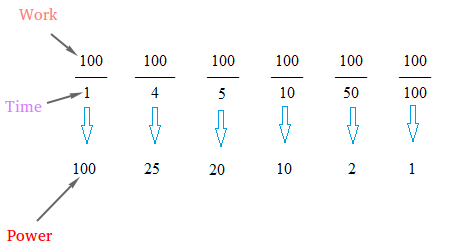Formula for power
The formula for power is not the same as the formula for work. The
formula for power is the ratio of the work done to the time it takes to
get that work done.
As you can see, power is the rate at which work is done. Another way to say this is , " How fast can you get the work done? "
Say for instance you can carry a load weighting 30 pounds to the third floor in 10 minutes.
However, your wife can carry the same load to the third floor in 6 minutes.
Then, your wife is more "powerful" than you because it takes her less time to do the same amount of work. Get off the sofa and go to the gym!
Take a look at the formula for power again. To get the power, whatever
the work is, divide by the time it takes to perform the task. Say for
instance the work is 100 joules. We show what the power is for different
time intervals starting with 1 second.

Notice that as the time gets bigger, the power gets smaller. This simple
math computation shows clearly why the power is less when the time
interval is more.
Another good way to see what power is to think of an automobile.
We usually say that vehicle x is more powerful than vehicle z.
We are of course referring to the amount of work the engine of the vehicles can do in a time frame.
The engine of vehicle x could be able to do work that can take the vehicle from 0 to 60 miles per hour in 10 seconds.
The engine of vehicle z, on the other hand, could be able to do work that can take the vehicle from 0 to 60 miles per hour in 5 seconds.
In this case, vehicle z is twice as powerful as vehicle x.
Power of course does not always refer to how fast you can do one thing compared to another thing. It could also mean being able to do more work in the same time frame.
Earlier, we talked about a wife being able to carry a load weighting 30
pounds to the third floor in 6 minutes while the husband could only do
the same in 10 minutes.
If the wife can carry a 60-pounds load to the third floor in 3 minutes while the husband can carry only 30 pounds to the third floor in 3 minutes, the wife is still more powerful than the husband.
By the same token, if vehicle z can do 0 to 120 m/h in 10 seconds while vehicle x can do 0 to 160 m/h in 10 seconds, we say that vehicle x is more powerful than vehicle z.
Another formula for power
To see why the work done is equal to the force multiplied by the displacement, please review the lesson about work.
Power = Force × velocity
To see why the velocity is equal to the displacement divided by the time interval, please review the lesson about velocity.
Unit of power
The unit of power is the joule per second or watt. The unit is named after James Watt who developed the steam engine. If you can do 1 joule of work in 1 second, that is 1 watt.
Kilowatt and megawatt are also used as units of power.
- 1 kilowatt = 1000 joules per second.
- 1 megawatt = 1000000 joules per second.
- 1 horsepower = 0.75 kw = 750 joules per second.
- 200 horsepower = 200 times 0.75 = 150 kw.
Horsepower is used a lot to rate or measure the power of an engine.
Think about it!
An elevator is replaced with a new elevator that has twice the power of the old elevator. How much greater a load can the new elevator lift in the same amount of time? If the new elevator lifts the same load, how much faster can it operate?
If you still cannot find the answers on your own, click here to see the solution.Power quiz
This power quiz will help you see if you understand the meaning of power
in physics. After completing this quiz, you should be able to clearly
see the difference between power and work and become familiar with some
of the units used for power. You may need to use a paper and pencil to
complete this quiz.
My recommendation is to first read this lesson about what power is in physics and then take this quiz without using a calculator.
Objective of the quiz:
- Know what power is
- Know the formula for power.
- Know the units used for power .
- Explore some real life examples of power.
- Know how to convert horsepower to kilowatts
- Know how to convert joules/s to kilowatts
|
Test your knowledge with the quiz below: |